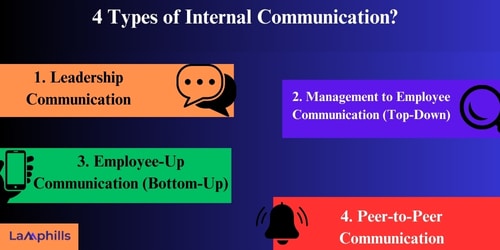You’ve poured your heart and soul into your latest product. It’s innovative, solves a real problem, and has the potential to be a game-changer. But then, launch day arrives, and…crickets. No website traffic, no social media buzz, and your phone remains silent. The harsh reality is that even the most incredible product needs a voice. That’s where external communication comes in.
It’s the bridge between your business and the outside world, the megaphone you use to tell your story and connect with the people who matter most. External communication isn’t just about press releases and marketing campaigns, though those are important tools. It’s the foundation for building relationships with customers, partners, and investors. It’s how you handle customer service inquiries, navigate media inquiries, and foster brand loyalty.
In short, effective external communication is the secret sauce that turns a hidden gem into a household name. So, let’s dive deeper into the different types of external communication and explore real-world examples to help you craft a powerful voice for your business.
Key Point:
- Internal communication is crucial in the internal works of an organization, ensuring workers are informed, motivated, and working towards the same vision.
- External communication involves exchanging information with customers, suppliers, investors, media, and the general public, fostering relationships, and amplifying brand stories. It involves using press releases, social media, customer reviews, and media inquiries to reach the public.
- External communication is crucial for businesses to maintain relationships with customers, share news, build brand identity, and improve brand awareness. It helps keep customers updated, and inform partners, shareholders, and clients about changes, attracting new audiences.
- External communication, such as blog posts, emails, and press releases, can boost website traffic and position an expert in a field. It goes beyond interviews and includes friendly interactions with customers.
What is Inward Communication?
What is External Communication
External communication is the exchange of information between a company and its customers, suppliers, investors, media, and the general public. It entails communicating messages and information about the firm, its products or services, and its ideals to the outside world.
Picture this: I spent months meticulously crafting the perfect website for my business. Design! Flawless. Functionality! Top-notch. But then, crickets. No visitors, no sales. It dawned on me – I built a beautiful house, but forgot to put up a sign! That’s where external communication comes in. It is a two-way street. We use press releases and social media to spread the word, but we also listen to customer reviews and respond to media inquiries.
At the beginning of this article, I said, It’s about building relationships with external audiences – customers, partners, investors, and even the media. We can think of it as a megaphone to amplify our brand story, but also a finely tuned ear to pick up on what people are saying about us. By mastering external communication, we transform our business from a hidden gem into a sought-after destination.
READ ALSO: Press Kit vs Media Kit: Which One Does Your Business Really Need?
What is The Aim of External Communication?

External communication is a vital aspect of every business since it allows the company to communicate with its consumers and access new markets. Here are a few goals for external communication that firms might incorporate into their marketing or communications strategy:
- Maintaining good relationships with existing customers: External communication helps to keep existing consumers. It may assist clients to stay up to date on new items while also increasing brand loyalty and affinity.
- Sharing news and developments about the business: It’s crucial to advise partners, shareholders, and significant clients of any changes to the firm or news that may influence their connection with the business.
- Building brand identity: The way a company communicates, the words it uses, and even the visuals it shares all contribute to the creation and reinforcement of a certain brand identity. This can assist build a bond between the company and its consumers and attract new audiences.
- Improving brand awareness: External communications, such as advertising campaigns, websites, and social media content, may all help to raise brand recognition and keep the public informed about a company.
What are Some Examples of External Communication?
I poured weeks into crafting the perfect blog post, one that broke down a complex scientific theory into bite-sized pieces. I hit publish, brimming with excitement, but my website traffic remained stagnant. It dawned on me that I hadn’t told anyone about it! Now, that’s where external communication swoops in to save the day. It’s the megaphone you use to shout your ideas, products, or services from the rooftops. I remember when my boss and I snagged that coveted interview with a local news channel to discuss our company’s blog. That was external communication in action. It not only boosted our website traffic but also positioned me as an expert in the field.
However external communication goes way beyond interviews. It’s the friendly email you send a customer thanking them for their purchase, or the witty social media post that sparks a conversation with potential clients. It’s even the press release you craft announcing a new product launch, hoping to grab media attention.
Examples of external communication include your e-mails and newsletters, social media, or press releases. Basically, any interaction your business has with the outside world – from casual chats to formal presentations – falls under the umbrella of external communication. It’s the magic that takes your fantastic work, like my blog post, and transforms it from a hidden gem into something the world can discover and appreciate.
READ ALSO: COMMUNITY RELATIONS: Best Strategies For Your Business
Download Lamphlls Checklist for External Communication Checklist
What are 3 Examples of Downward Communication?
I vividly remember coming out of college. I started my first marketing job at a fast-paced tech startup. We were a small team, ideas flew fast, and priorities constantly shifted. One minute I was crafting social media content, the next I was knee-deep in website redesign. But the information flow felt…off.
Deadlines snuck up on me, and sometimes I’d be scrambling to understand a new project’s goals. That’s when I learned about downward communication. It’s like the oxygen of any organization, the flow of information from leadership to the team. Here’s how I experienced three key types of downward communication:
#1. Company-Wide Emails
Company-wide emails are messages sent to all employees within an organization, conveying important information, updates, announcements, or directives. These emails serve as a means of communication to ensure that all staff members are informed and aligned with company goals, policies, and initiatives.
Every Monday, the CEO would blast an email outlining the week’s top priorities and upcoming industry events. This big-picture view helped me connect my daily tasks to the company’s overall strategy.
#2. Performance Reviews
Performance reviews are assessments conducted by employers to evaluate an employee’s job performance, strengths, weaknesses, and accomplishments. They typically occur annually or semi-annually and involve feedback discussions between managers and employees.
Then, my manager and I would meet quarterly to discuss my progress. It wasn’t just a numbers game; we talked about specific projects, what worked well, and areas for improvement. This clear, two-way communication motivated me and helped me course-correct when needed.
#3. Training Sessions
Training sessions are structured learning events designed to impart knowledge, develop skills, or enhance competencies among participants. Whenever a new software rolled out or a marketing strategy shifted, we had mandatory training sessions.
These weren’t just lectures; they were interactive workshops where we could ask questions and practice what we learned. This ensured everyone on the team was on the same page and equipped to succeed. Downward communication, I realized, wasn’t just about telling us what to do – it was about empowering us to do it well.
What is Another Name For Internal Communication?

There are other names for internal communication, like “employee communications, staff communications employee engagement, employee relations, internal marketing, and company communications.” It’s basically the way information travels within a company, keeping everyone on the same page and fostering collaboration. It can be emails, company meetings, or even a fun, internal social media platform. The key is ensuring everyone has the information they need to do their jobs well, avoiding that frustrating game of telephone for good.
READ ALSO: Everything You Should Know About Entertainment Journalism
What are The 4 Types of Internal Communication?

I once worked at a fantastic ring blog startup, our product was ingenious! But teamwork became a nightmare. Designers had no clue what engineers were building, and sales were pitching features that didn’t exist. Communication broke down, and so did our project. That’s why internal communication (IC) is crucial. It’s the lifeblood of any organization, ensuring everyone’s on the same page. Here are the 4 types of internal communication that help our teamwork:
#1. Leadership Communication
It is the exchange of information, ideas, and direction from organizational leaders to employees. It involves conveying vision, goals, and strategies, inspiring and motivating teams, and fostering alignment and trust throughout the organization.
#2. Management to Employee Communication (Top-Down)
Communication flows where directives, policies, and information are disseminated from higher-ranking managers or executives to lower-level employees. It ensures alignment with organizational objectives, facilitates coordination, and provides guidance for task execution.
#3. Employee-Up Communication (Bottom-Up)
Communication flows where feedback, suggestions, and concerns are communicated from lower-level employees to higher-ranking managers or executives. It promotes employee engagement, empowerment, and participation in decision-making, fostering a culture of transparency and inclusivity.
#4. Peer-to-Peer Communication
Communication exchange between individuals at similar hierarchical levels within an organization. It facilitates collaboration, knowledge sharing, and problem-solving among coworkers, enhancing teamwork, morale, and productivity. Peer-to-peer communication often occurs informally but can also be structured for specific purposes such as project coordination or skill development.
Conclusion
By crafting a clear and consistent external communication strategy, I transformed my business. We built relationships with customers through social media engagement, addressed their concerns with exceptional customer service, and even landed media coverage with targeted press releases. Now, our brand is recognized, our customers are loyal, and our phones are ringing off the hook! Effective external communication isn’t magic, it’s a strategic approach.
It’s about understanding your audience, choosing the right channels, and delivering messages that resonate. So, invest in external communication – it’s the bridge that connects your business to success. Remember, strong external communication isn’t a one-time thing, it’s an ongoing conversation. Keep refining your approach, listen to your audience, and watch your business flourish.
Related Articles
Best Free Press Release Distribution Sites for 2024
WHAT ARE THE DIFFERENCES BETWEEN SOCIAL LISTENING & MONITORING?
The Top 2024 Business Journalists & Everything You Need





